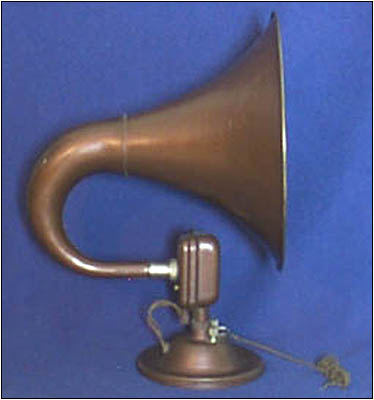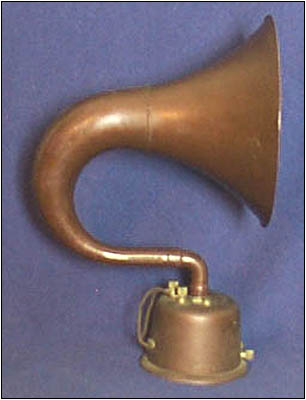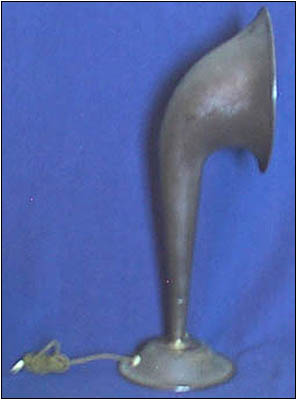Of Old Radios And Related Items--Published Monthly
The Bristol Audiophone Family
BY DAVE GONSHOR
Web Edition
Horn speakers in all sizes and shapes have an endless fascination for collectors. Dave Gonshor shares his interest in a long-lived New England manufacturer, the Bristol Manufacturing Company, maker of the Audiophone line of speakers for battery sets of the 1920s. (Editor)
The Bristol Manufacturing Company was established in 1889 in Naugatuck, Connecticut. Bristol pioneered the manufacture of recording products, including the circular chart recorder still used throughout industry today. In 1892, the company moved to Waterbury, Connecticut, where it remained for 95 years. Throughout the years, Bristol produced a wide variety of product lines, including radio equipment.

Figure 1. The Bristol Senior horn speaker sold for $32.50.
The Bristol Company produced a series of horns for battery sets of the 1920s. Much along the storyline in the Grimm's fairy tale of "Goldilocks and the Three Bears," Bristol produced three horns called the "Senior," "Junior" and "Baby." These were very well built units presumably designed for a higher end market. The trade name applied to these horns was "Audiophone."
The Senior and Junior, shown in Figures 1 and 2 respectively, are C-neck horns that use armature type drivers with impedance matching transformers. The armature type driver was chosen by the industry to drive the higher fidelity cone speakers introduced shortly after the Bristol horns were made. Shown in Figure 3 (see print version), a Bristol ad for a Super S model refers to a large, low-pitch diaphragm capable of deep bass notes. This could have been the same armature-driven diaphragm used in the Senior and Junior.

Figure 2. The Bristol Junior horn speaker contained a matching transformer in its base.
Both the Senior and Junior are made of metal, while the Baby material is "composition." The Senior is the tallest of the three at 211/2"; its bell size is 153/8". The Junior bell size is 11"; the Baby bell size, 103/8". The matching transformer is located in the base of the Senior and the Junior.
"Bristol Audiophone" is cast into the neck of the Senior and Junior near the connector to the base. The Senior has the manufacturer and model identified on a plate on the back of the driver unit, while the Junior manufacturer and model identification apprears on the base.
The Baby, shown in Figure 4, is a smaller straight neck horn using a conventional, iron diaphragm-type driver, also known as the headphone driver. A plate at the top of the base identifies the manufacturer and the model.

Figure 4. The Baby horn speaker used a conventional iron diaphragm-type driver.
Both the Senior and the Junior have an input resistance to the transformer of only 240 ohms, unusual for a battery set speaker. The Baby has a coil resistance of 1,000 ohms, similar to many other horn speakers.
All three horns have distinguishing features making them very collectible, as seen in the photographs. The family of horns is shown together in Figure 5 (see print version) for size comparisons.
Floyd Paul's book The Radio Horn Speaker Encyclopedia identifies horns made by Bristol other than those of the "family." These horns are the J, the S, and the Baby Grand. Note that the Audiophone Baby was produced in three versions, probably with three different horn bell sizes. The Junior was made in two versions.
In addition, the Bristol ad refers to a Super C and a Cabinet type speaker. Bristol also produced other radio components. Johnson's book Guide to Old Radios identifies a 1-tube amp built by Bristol, but no model number is given.
The three horns pictured are from my collection. The Senior was purchased from an antique store; the Baby, from a fellow collector. The base for the Junior was purchased from an ad in A.R.C. To complete the Junior speaker and the set, I purchased the horn for the Junior through a "wanted" ad in A.R.C.
It is interesting to note that the Junior horn was spotted at a garage sale a thousand miles from my home base. The prospective buyer went home, got on the computer, and did a search on the "Bristol Audiophone" marking on the neck of the horn, and came up with my A.R.C. ad! A.R.C. ads can go beyond the subscribers, thanks to the Internet. After a phone call and the transfer of funds, the horn was reunited with the base. It was meant to be.
The Bristol Company, now known as Bristol Babcock, is still in business today as a leading, worldwide supplier of instruments and measurement and control systems. It is located in Watertown, Connecticut, only nine miles from the Waterbury operation that produced early radio equipment.
References:
Bristol History: Web site http://www.bristolbabcock.com/aboutbristol/history.htm.
Paul, Floyd A. Radio Horn Speaker Encylopedia. Glendale, Cal.: Floyd A. Paul, 1986.
Johnson, David and Betty. Guide to Old Radios, Second Edition. Radnor, Penn.: Wallace-Homestead Book Co., 1995.
Radio Broadcast Advertiser, January 1926, p. 358.
(David Gonshor, 7121 S. Jellison St., Littleton, CO 80128)
Dave Gonshor, an electrical engineer, specializes in battery sets and horns from the 1920s, as well as interesting AC sets from the 1930s. He enjoys the more challenging restoration of the AC sets.
| [Free Sample] [Books, etc., For Sale] [Subscribe to A.R.C./Renew] [Classified Ads] [Auction Prices] [Event Calendar] [Links] [Home] [Issue Archives] [Book Reviews] [Subscription Information] [A.R.C. FAQ] URL = http://www.antiqueradio.com/Apr02_Gonshor_Bristol.html Copyright © 1996-2002 by John V. Terrey - For personal use only. Last revised: March 23, 2002. For Customer Assistance please contact ARC@antiqueradio.com or call (866) 371-0512 Pages designed/maintained by Wayward Fluffy Publications
Antique Radio Classified |